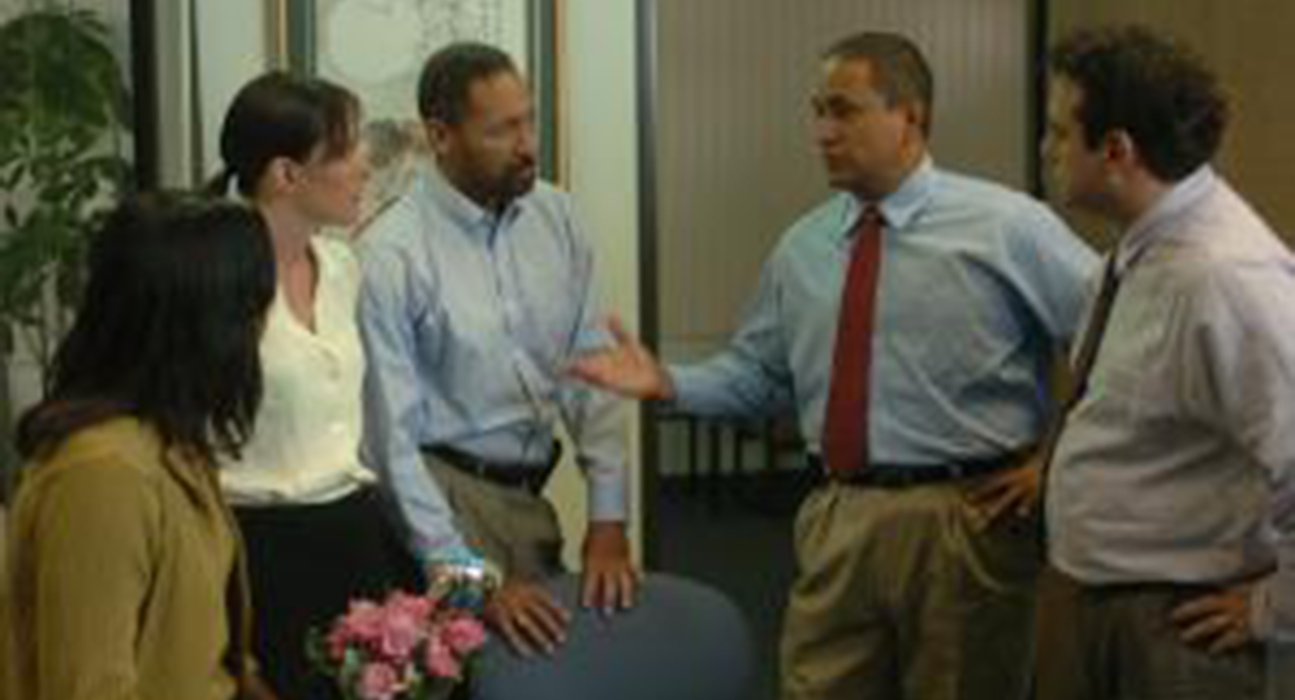The Science of Storytelling: How Storytelling Shapes Our Behavior

The Power of Storytelling and How to Harness it in L&D
What do you think of when you hear the word “dog”? Perhaps you picture a bone, a tennis ball, or your own cuddly companion. Maybe you recall the feeling of slobbery kisses when you get home from work, or the smell of musty fur after your pup’s been playing in the river all day. Your mind may ponder traits such as loyalty or joy.
When we hear or read a word, hundreds of signals activate the visual, auditory, and language-processing regions of our brains in a matter of milliseconds. They tap into our working memory, long-term memory, and even our subconscious to give things meaning.
Considering all these responses are elicited by a single word, imagine what your brain looks like while processing an entire story.


Stories and the Brain
Scientist, entrepreneur, and author Paul J. Zak has performed extensive research on the power of storytelling and its effects on attitudes, beliefs, and behavior. Recently, he and his team discovered that character-driven stories not only elicit a physiological response, they also inspire behavior change. Through a recent experiment, Zak found that the physiological response triggered by an emotionally-fueled narrative predicts a person’s likelihood to engage in cooperative behaviors. In other words, the more a story resonates with an individual, the more likely they are to change their behavior.
Think back to your favorite movies, books, or television shows – what do you remember? Perhaps you visualize a specific scene or recall a famous line; maybe you remember how it made you feel and the fire it ignited within you.
Odds are, your favorite stories – the ones that shaped you – are memorable because they activated multiple parts of your brain. More active brain regions lead to greater information retention, which is why certain stories are more memorable than others. It’s also why we tend to better retain important facts, figures, and events when they’re intertwined in a captivating story. This higher retention significantly increases our potential for behavior change.
Zak attributes this phenomenon to the brain’s production of two chemicals. The first is cortisol, also known as the stress hormone. It focuses our attention when we encounter feelings of distress or anxiety. The second is oxytocin, which regulates social interaction and is associated with feelings of care, trust, and empathy. According to Zak’s research, the amount of these two chemicals released by the brain predicts how willing people are to help others (i.e. change their behavior).
Other research detected the presence of another key compound released during storytelling: dopamine. Think of it as a reward system for staying engaged in a captivating story. Dopamine aids in memory and processing information. When witnessing an emotionally charged event, the brain releases the neurotransmitter from a structure called the amygdala. It’s dopamine you have to thank for your 14-hour Netflix binges and subsequent trivia mastery.
The Power of Storytelling
When used effectively, storytelling is a vehicle for change. It helps us unpack ideas, expose alternate realities, comprehend different perspectives and, ultimately, change our behavior for the better.
Exploring Abstract Ideas and Alternate Realities
Stories are our means of understanding the world around us and making sense of our own experiences. They break down complexities, exploring big themes and questions through a narrow lens.
As far as we know, we cannot climb through a magic wardrobe that takes us to an alternate dimension with talking animals and ice queens ; neither can we travel to the farthest reaches of the galaxy and join the rebellion against the Galactic Empire (much to my own dismay). However, a good story can get us pretty darn close. Stories hold the power to transport us to these distant, impossible lands. They make the mountaintops attainable and the seas less vast, allowing us to safely explore realities that otherwise pose too high a risk.
This is great news for workplace learning. Harnessing the power of storytelling provides trainers with the ultimate sweet spot: the opportunity to explore a high-risk situation with the guarantee of safety. It’s a space in which employees can practice navigating delicate, dangerous, or uncomfortable circumstances in a safe, yet realistic manner.
Understanding Different Perspectives and Empowering Learners
Remember what we learned about oxytocin? The brain releases it in the presence of an impactful story. Its release is closely tied to empathy— one of the key elements in understanding different perspectives. Good storytelling leaves the audience with something new to chew on. It can broaden our understanding of uncharted cultures, practices, and industries, as well as deepen our comprehension of those we’re already familiar with. Stories can even help us understand our own psyches, slyly uncovering our unconscious biases and disrupting stereotypes.
“…storytelling is a collaborative non-hierarchical process that involves the learners as active agents in the learning process rather than as passive receivers.”
R.L Lawrence and D.S. Paige, What Our Ancestors Knew: Teaching and Learning Through Storytelling
Whether you’re conscious of it or not, you are an active participant when listening to a story. Your brain synthesizes different stimuli giving you multiple access points back to the information you’re receiving. This is probably why you feel you learned so much from favorite teachers, professors, and speakers—they were good storytellers, able to transmit information in a memorable way.
How to Tell a Good Story - Using Storytelling to Enhance Training


Zak’s research discovered two key aspects of an effective story. First, it must capture and sustain the audience’s attention; and second, it must “transport” the audience into the world of the characters.
Using Zak’s findings as a starting point, here are a few areas to focus on when drafting your next training narrative:
1. Know Your Audience
A good story caters to audience preferences. A storyteller must have a firm grasp on the audience’s logic, core principles, the objects or ideals they value most, and what embodies or gains their trust. The story must also be relatable as it makes the curriculum content “more real, more immediate, and more personal” (Rossiter & Clark, 2007). To incorporate storytelling into employee training, first identify your program’s key messages or takeaways. Then try creating a profile for your trainees by listing 3-5 of their core values or traits. Find the overlaps and connect the dots.
2. Get Creative, Dang It
This one’s a given (almost a cliché at this point), yet it’s arguably one of the most glossed over elements in business settings. Human brains crave novelty; our focus is piqued when we encounter something new. In preparation for your next training session, try to think outside the box. Invite other perspectives into the brainstorming process, especially those aligning with your trainees’. Think bigger than the placeholder anecdotes used dozens of times before. Remember: if it’s not quite resonating with you, it’s not going to resonate with your audience.
"If you tell me, it’s an essay. If you show me, it’s a story."
Barbara Greene, Canadian Politician
3. Show, Don't Tell
Ever been told to do something, but had the burning desire to do the complete opposite? If so, you’re not the only one—turns out this act of rebellion is rather common. In fact, deflection is a natural response to explicit instruction. No one likes being told what to do. We build walls and shut down when we feel preached at, dominated, or bored. When you’re drafting your next story, focus on evoking the senses or emotions. Because character-driven narratives generate an emotional response, our brains are naturally more attuned to them than data, facts, and abstractions. As we’ve learned already, you tend to retain more when you’re emotionally invested.
4. Experiment with Different Mediums
Why is it that certain songs or paintings so often elicit an emotional response? Research shows that this kind of expression can unlock regions of the brain where stories reside but are not in immediate conscious awareness (Rossiter & Clark, 2007) . As society has evolved, so has our capacity for storytelling. Today, stories may be told orally, visually, or physically. Those incorporating multiple elements are more likely to harness multiple regions of the brain, proving more memorable in the long term.
The Stories that Shape Us, and Help Us Remember
Stories reflect our humanity. They shape our lives, igniting our imaginations and dictating the way we make choices. The stories you heard as a child, the tales your relatives would re-tell throughout your youth, your favorite books, movies, and TV shows—all had a profound hand in shaping your life, whether you were aware of it or not.
Whatever the story, it led to some sort of change. It left you feeling different. What you did with that feeling could’ve been significant or miniscule, but at the very least—you remembered.
As an L&D professional, you are in the business of helping people remember--teaching in such a way that information is retained and applied. Especially in an age where massive amounts of data, headlines, and information bombard us on a daily basis, the ability to remember is, arguably, a miracle in itself. Storytelling empowers you to bring forth that miracle. We encourage you to harness it.
Media Partners courses tap into the the power of storytelling through the use of compelling video examples based on true events. Here are a few examples:
Clip from Unintentional Still Hurts
Overcoming Unconscious Bias.
Clip from How Was Your Day?
Getting Real About Bias, Inclusion, Harassment, Bullying
To learn more about our powerful approach to engaging learners and inspiring behavior change, browse our training solutions.
Jerrin graduated with a degree in Speech Pathology/Audiology and minor Entrepreneurship. Her extensive research and studies on the science of communication have richly informed her passion for storytelling.








